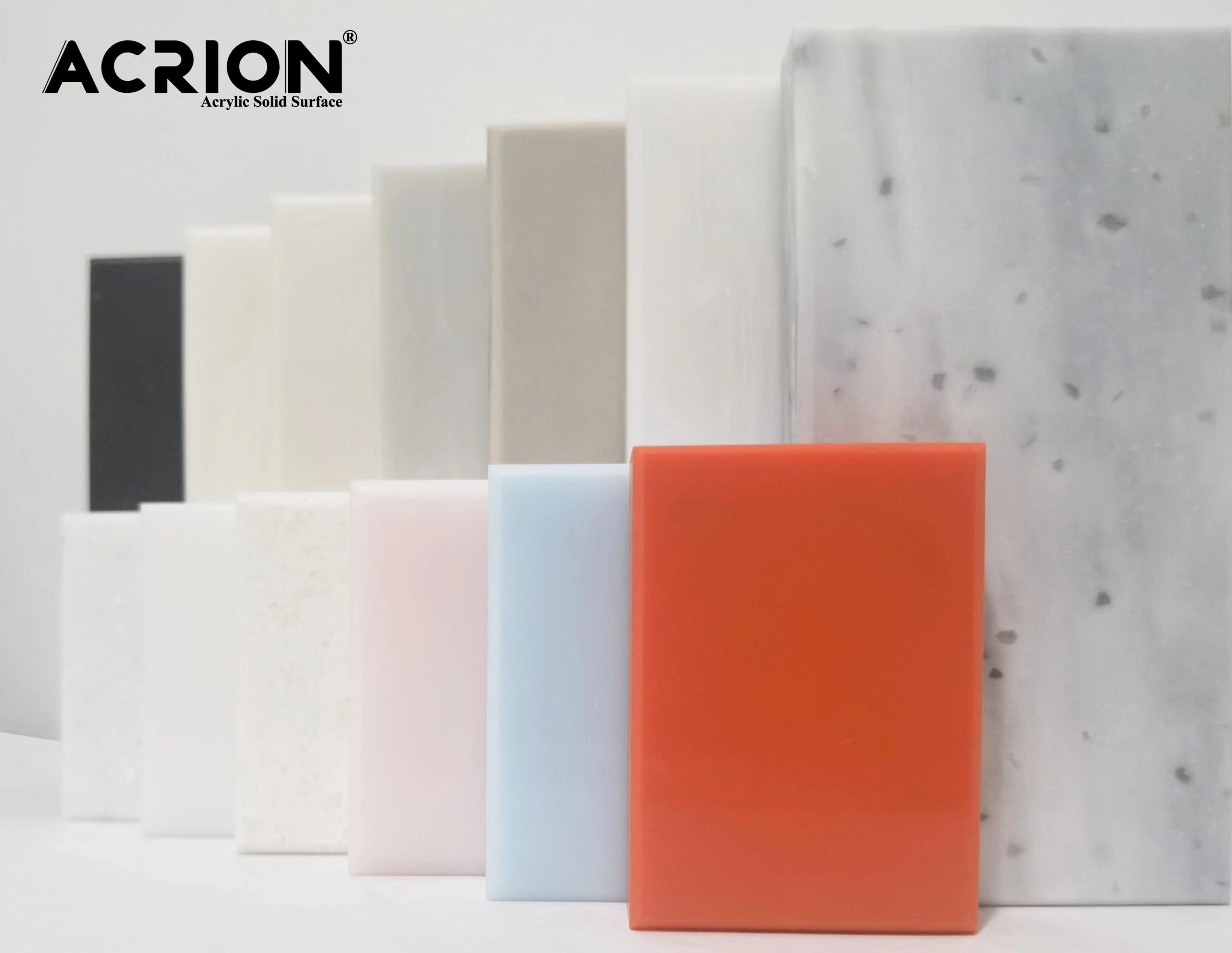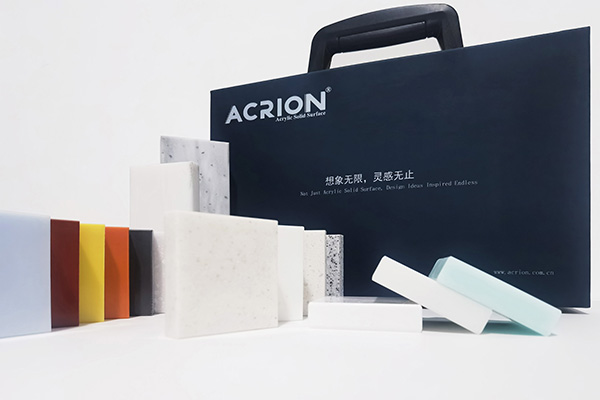Análisis de propiedades antibacterianas y antifúngicas en la superficie del sólido acrílico
El rendimiento antibacteriano y antifúngico de la superficie sólida acrílica está influenciado por la tecnología de modificación de resina, los tipos de aditivos y las condiciones ambientales. El siguiente análisis se realiza a partir de tres aspectos: mecanismo antibacteriano, rendimiento antifúngico y factores de influencia:
Primero, las fuentes y mecanismos de las propiedades antibacterianas
Agente antibacteriano dopaje
Las funciones antibacterianas pueden dotarse al recubrimiento introduciendo agentes antibacterianos inorgánicos (como óxido de zinc, iones de plata) o agentes antibacterianos orgánicos (como sales de amonio cuaternario) en resina acrílica. Por ejemplo, el óxido de zinc puede generar actividad fotocatalítica bajo irradiación de luz ultravioleta, liberando iones de zinc para destruir las membranas celulares de las bacterias, inhibiendo así la proliferación bacteriana. Los experimentos muestran que el recubrimiento acrílico que contiene óxido de zinc todavía puede mantener una alta actividad antibacteriana después de simular el desgaste diario. La liberación de iones de zinc aumenta significativamente después del tratamiento con desgaste, y el efecto antibacteriano fotocatalítico es sobresaliente.
Tecnología de modificación de la superficie
Los grupos antibacterianos se introducen en la superficie de la resina acrílica a través del injerto químico o la mezcla física. Por ejemplo, mezclar agentes antibacterianos que contienen siloxano con resinas acrílicas pueden dotar la superficie de recubrimiento con hidrofobicidad y propiedades antibacterianas, reduciendo la adhesión bacteriana. Además, la introducción de agentes nano-antibacterianos (como nano-silver) puede mejorar aún más el rendimiento antibacteriano, pero su dispersión debe controlarse para evitar la aglomeración.
Antibacteriano ambientalmente sensible
Algunos recubrimientos acrílicos pueden desencadenar mecanismos antibacterianos a través de estímulos ambientales como la humedad y la luz. Por ejemplo, en un entorno húmedo, la tasa de liberación del agente antibacteriano en el recubrimiento se acelera, mejorando así el efecto antibacteriano. Esta característica es adecuada para los requisitos antibacterianos en entornos de alta humedad, como baños y cocinas.
En segundo lugar, el rendimiento y los factores de influencia del rendimiento contra el molde
Mecanismo contra el molde
El rendimiento contra el molde del recubrimiento acrílico depende principalmente de su densa estructura superficial y baja tasa de absorción de agua. Por ejemplo, al optimizar la fórmula de resina y el proceso de curado, se puede reducir la porosidad de la superficie de recubrimiento, inhibiendo así la adhesión y el crecimiento de las esporas de moho. Además, agregar fungicidas (como las isotiazolinonas) puede mejorar aún más el efecto anti-molde, pero se debe prestar atención a su compatibilidad con la resina.
La influencia de las condiciones ambientales
El crecimiento del moho requiere la satisfacción de tres elementos: humedad, temperatura y sustrato de nutrientes. Por ejemplo, en un entorno con una temperatura que oscila entre 25 y 30 ℃ y una humedad de ≥80%, la tasa de crecimiento del moho se acelera significativamente. El recubrimiento acrílico debe tener una buena resistencia al agua y una transpirabilidad para evitar que la acumulación de agua en la superficie cause crecimiento del moho. Además, el valor de pH de la superficie de recubrimiento también afecta el rendimiento contra el molde. Un ambiente neutral o débilmente alcalino es más propicio para inhibir el crecimiento del moho.
Durabilidad a largo plazo
El rendimiento contra el molde del recubrimiento acrílico puede disminuir con el tiempo. Por ejemplo, en los entornos al aire libre, la radiación ultravioleta y la erosión de la lluvia pueden hacer que la superficie de recubrimiento esté en edad y el agente anti-molde se pierda, reduciendo así el efecto anti-molde. Por lo tanto, la vida útil del recubrimiento debe prolongarse agregando estabilizadores de luz y resinas resistentes a la intemperie.
Tercero, los factores clave que afectan el rendimiento antibacteriano y antifúngico
Tipos y dosis de agentes antibacterianos
El efecto antibacteriano de los agentes antibacterianos inorgánicos (como el óxido de zinc y los iones de plata) es duradera, pero puede afectar la transparencia y las propiedades mecánicas del recubrimiento. Los agentes antibacterianos orgánicos (como las sales de amonio cuaternario) tienen una velocidad antibacteriana rápida, pero su resistencia al calor y su durabilidad son relativamente pobres. Por ejemplo, el contenido excesivo de iones de plata puede hacer que el recubrimiento se decolore, y la cantidad de adición de óxido de zinc debe controlarse al 5-10% para equilibrar el rendimiento antibacteriano y el rendimiento de recubrimiento.
Características de la matriz de resina
La temperatura de transición de vidrio (TG) y la densidad de reticulación de la resina acrílica afectan la velocidad de liberación de los agentes antibacterianos. Por ejemplo, la alta resina TG puede ralentizar la liberación de agentes antibacterianos y prolongar el efecto antibacteriano; La reticulación moderada puede mejorar la densidad del recubrimiento y reducir la adhesión del moho. Además, cuanto más fuerte sea la hidrofobicidad de la resina, mejor es su rendimiento anti-molde.
Condiciones de construcción y curado
La temperatura y la humedad del entorno de construcción afectan el efecto de curado y el rendimiento antibacteriano y antifúngico del recubrimiento. Por ejemplo, el curado en condiciones de baja temperatura o alta humedad puede conducir a un estrés interno desigual en el recubrimiento, reduciendo su durabilidad. Además, el tiempo de curado y la intensidad de la luz también afectarán el efecto de reticulación y fijación del agente antibacteriano.
Cuarto, escenarios de aplicación de rendimiento antibacteriano y antifúngico
Instalaciones médicas
Los requisitos de rendimiento antibacteriano para recubrimientos en salas de hospitales, quirófanos y otros lugares son extremadamente altos. Por ejemplo, los recubrimientos antibacterianos acrílicos se pueden aplicar a las paredes y las superficies de los muebles para reducir el riesgo de transmisión bacteriana. Dichos recubrimientos deben tener propiedades antibacterianas altamente eficientes (como una tasa de inhibición de ≥99% contra Escherichia coli y Staphylococcus aureus) y durabilidad a largo plazo.
Planta de procesamiento de alimentos
La contaminación del moho en el entorno de procesamiento de alimentos debe controlarse estrictamente. Por ejemplo, el recubrimiento acrílico contra el molde se puede aplicar a las paredes del taller y las superficies de los equipos para evitar el crecimiento del moho y la contaminación de los alimentos. Dichos recubrimientos deben tener resistencia química (como resistencia a los ácidos, álcalis y agentes de limpieza) y bajas emisiones de VOC para cumplir con los requisitos de seguridad alimentaria.
Edificios públicos
Las paredes y pisos en lugares públicos como escuelas y centros comerciales son propensos a la contaminación microbiana. Por ejemplo, los recubrimientos antibacterianos acrílicos y antimillidos se pueden aplicar a áreas con frecuencia tocadas, como baños y botones del elevador, lo que reduce el riesgo de infección cruzada. Tales recubrimientos deben ser resistentes al desgaste y fácil de limpiar para mantener los efectos antibacterianos a largo plazo.
Quinto, estrategias para mejorar el rendimiento antibacteriano y antifúngico
Sistema antibacteriano compuesto
Al agravar los agentes antibacterianos inorgánicos con agentes antibacterianos orgánicos, se puede lograr un efecto antibacteriano de amplio espectro. Por ejemplo, el efecto sinérgico del óxido de zinc y los agentes antibacterianos de sal de amonio cuaternario pueden inhibir simultáneamente el crecimiento de bacterias y mohos. Además, la adición de fotocatalizadores (como el dióxido de titanio) puede mejorar el rendimiento antibacteriano fotocatalítico del recubrimiento.
Control de microestructura de superficie
Al regular la morfología microscópica de la superficie de recubrimiento (como la rugosidad y la porosidad), se puede reducir la adhesión de microorganismos. Por ejemplo, la aplicación de tecnología de superficie superhidrofóbica puede hacer que el ángulo de contacto de la superficie de recubrimiento ≥150 °, inhibiendo así la adhesión de esporas de moho. Además, el diseño de patrones de superficie también puede reducir el área de contacto para microorganismos.
Tecnología Anti-Moldia duradera
El tiempo de acción de los fungicidas se prolonga a través de la tecnología de liberación lenta. Por ejemplo, los fungicidas pueden encapsularse en las microcápsulas, lo que les permite liberar gradualmente durante la aplicación del recubrimiento, manteniendo así un efecto fungicida a largo plazo. Además, agregar materiales de autocuración puede permitir que el recubrimiento se repare automáticamente después de ser dañado y restaurar su rendimiento contra el molde.



